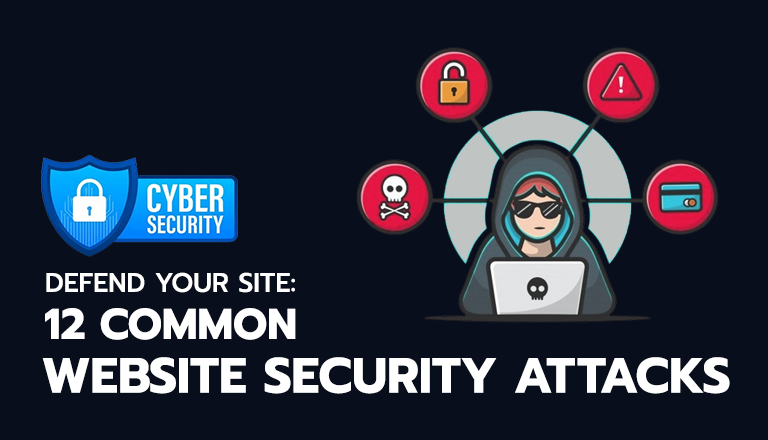Navigating the world of website security can often feel like steering a ship through stormy seas.
For small website owners, understanding and protecting against common website security attacks is not just a technical challenge, but a crucial step in safeguarding their digital presence.
This comprehensive guide aims to illuminate the murky waters of cyber threats. From the disruptive force of Denial-of-Service (DoS) attacks to the cunning deception of SQL injections, we will delve into each attack type, exploring how they work and, most importantly, how to prevent them.
Let’s embark on this journey to make your website not just a beacon in the digital world but also a fortress.
1. Denial-of-Service (DoS) Attacks
Imagine your website as a busy storefront. Now, picture a sudden, overwhelming crowd blocking the entrance, preventing your genuine customers from entering. That’s what a Denial-of-Service (DoS) attack does to your website. It’s an attempt to make a machine or network resource unavailable to its intended users by temporarily or indefinitely disrupting services of a host connected to the Internet.
How DoS Attacks Work
- Traffic Flood: DoS attacks inundate your site with more traffic than it can handle.
- Resource Exploitation: They exploit vulnerabilities, causing your site to consume all its resources, leading to a crash.
- Tools Involved: Attackers often use botnets, or a network of compromised computers, to launch these attacks.
Preventing DoS Attacks
- Network Security Tools: Implement tools like firewalls, anti-spam filters, and load balancers.
- Regular Updates: Keep all systems updated to patch vulnerabilities.
- Monitor Traffic: Regularly monitor your website’s traffic to spot unusual patterns early.
2. SQL Injection
SQL Injection is like leaving the door to your data vault unlocked, allowing cyber intruders to sneak in unnoticed. It is a prevalent attack method where attackers exploit a vulnerability in your website’s database management software. This breach occurs when your site unknowingly executes malicious SQL statements, compromising data integrity and confidentiality.
How SQL Injection Works
- Malicious Code Insertion: Attackers insert malicious SQL code into a website’s input fields.
- Manipulating Queries: This code manipulates your database, allowing unauthorized access or data manipulation.
- Data Theft and Tampering: Sensitive data like customer information and passwords become vulnerable to theft and tampering.
Preventing SQL Injection
- Input Validation: Ensure that your website rigorously validates user inputs.
- Use Prepared Statements: With parameterized queries, you can prevent attackers from changing the intent of your SQL queries.
- Regularly Update and Patch: Keep your database management systems updated to protect against known vulnerabilities.
3. Cross-Site Scripting (XSS)
Cross-Site Scripting (XSS) is akin to a chameleon in the cyber world – it deceives and manipulates without being noticed. It is a security vulnerability that allows attackers to inject malicious scripts into web pages viewed by other users. This attack targets the users of the website rather than the website itself, making it a unique and dangerous threat.
How XSS Works
- Injection of Malicious Scripts: Attackers inject harmful scripts into web pages that are then viewed by unsuspecting users.
- Script Execution: These scripts execute when users visit the compromised page, leading to data theft or session hijacking.
- Impact on Users: The user’s browser trustingly executes the script, compromising their interaction with the website.
Preventing XSS Attacks
- Sanitize User Input: Ensure that user input is properly sanitized to remove or disable harmful scripts.
- Content Security Policy (CSP): Implement CSP headers to restrict the browser from executing malicious scripts.
- Use Secure Coding Practices: Educate developers about secure coding techniques to prevent XSS vulnerabilities.
4. Cross-Site Request Forgery (CSRF)
Cross-Site Request Forgery (CSRF) is akin to a digital impersonation act, where attackers trick users into executing unwanted actions on a web application where they’re authenticated. It’s like sending a letter on someone else’s behalf without their knowledge. This attack exploits the trust a site has in the user’s browser, potentially leading to unauthorized commands being transmitted.
How CSRF Works
- Exploiting User Authentication: Attackers exploit the user’s current authentication session with the website.
- Malicious Requests: They trick the user’s browser into sending a forged request, such as changing account details or initiating transactions.
- Unaware User Actions: The user, unaware of this manipulation, unknowingly performs actions on behalf of the attacker.
Preventing CSRF Attacks
- Use Anti-CSRF Tokens: Implement tokens that verify the authenticity of requests made by the user.
- SameSite Cookies: Configure cookies with the ‘SameSite’ attribute to prevent them from being sent in cross-site requests.
- User Verification: Incorporate additional user verification steps for sensitive actions, like sending money or changing passwords.
5. Broken Authentication
Broken Authentication is like having a flawed lock on your door – it might look secure, but it’s easy to bypass. This type of attack exploits weaknesses in your website’s authentication and session management processes, allowing attackers to assume the identities of other users.
Common Authentication Attack Methods
- Credential Stuffing: Automated scripts try stolen username-password pairs on various websites.
- Session Hijacking: Attackers exploit vulnerabilities to take over a user’s session token, gaining unauthorized access.
- Insecure Password Recovery Mechanisms: Weaknesses in these mechanisms can allow attackers to reset user passwords and gain access.
Preventing Authentication Attacks
- Multi-Factor Authentication (MFA): Implement MFA to add an extra layer of security beyond just passwords.
- Strong Password Policies: Enforce policies for complex passwords and encourage regular changes.
- Secure Session Management: Use secure, encrypted session tokens and ensure they’re invalidated upon logout or expiration.
6. Sensitive Data Exposure
Sensitive Data Exposure, much like leaving confidential documents out in the open, occurs when a website inadvertently exposes personal or confidential information. It’s a serious issue where attackers gain access to data like credit card numbers, health records, or personal identification information due to inadequate protection measures.
Sources Of Potential Data Exposure
- Insecure Storage: Storing sensitive data without adequate encryption.
- Inadequate Data Transfer Security: Transmitting data over unsecured channels.
- Lack of Proper Data Handling Policies: Failing to implement policies for data retention and disposal.
Preventing Sensitive Data Exposure
- Encryption: Use strong encryption for storing and transmitting sensitive data.
- Access Controls: Limit access to sensitive data based on user roles and needs.
- Regular Audits: Conduct regular security audits to identify and rectify potential exposure risks.
7. Security Misconfiguration
Introduction to Security Misconfiguration
Security Misconfiguration is akin to forgetting to lock some doors and windows in your house. It happens when security settings are not defined, implemented, or maintained properly, often leading to unnecessary vulnerabilities.
Examples Of Security Misconfigurations
- Default Settings: Not changing default configurations and passwords.
- Outdated Software: Failing to update software, leaving known vulnerabilities unpatched.
- Unnecessary Features: Keeping unnecessary features or services enabled, which may provide potential attack surfaces.
Preventing Security Misconfigurations
- Regular Configuration Reviews: Periodically review and update security configurations.
- Minimalist Approach: Disable any unnecessary features, services, and accounts.
- Patch Management: Implement a robust patch management strategy to ensure software is always up-to-date.
Additional Website Security Attacks And Risks
In this ever-evolving digital era, new types of attacks are constantly emerging. Some of these include:
8. File Inclusion Vulnerabilities
File Inclusion Vulnerabilities present a significant risk, particularly in web applications. These vulnerabilities arise when a script allows unauthorized access to files on a server, potentially leading to sensitive data exposure or malicious code execution.
The two main types are Local File Inclusion (LFI) and Remote File Inclusion (RFI), where LFI exploits local files and RFI targets files from external sources.
To combat this, strict input validation is essential. Implement a whitelist of permitted files and regularly audit your security systems.
9. Zero-Day Exploits
Zero-Day Exploits are a ticking time bomb in cybersecurity. They exploit unknown vulnerabilities in software, leaving developers scrambling to patch them. These attacks are dangerous due to their unpredictability and potential for significant damage before a fix is available.
Staying vigilant is key. Employing a robust security infrastructure with advanced threat detection systems can provide early warnings. Regularly updating software and educating your team about potential threats are also crucial defense strategies.
10. Third-Party Component Risks
Third-Party Component Risks arise when external software components are integrated into your website without proper testing. These components, like plugins or widgets, can introduce vulnerabilities if they’re not regularly updated or securely developed.
It’s like adding an untested ingredient to a recipe – it might work well, but it can also spoil the dish.
To mitigate these risks, thoroughly review and regularly update all third-party components. Establish a process for continuously monitoring these components for new vulnerabilities. By treating third-party components with the same rigor as your own code, you can significantly reduce associated risks.
11. Malware Infections
Malware Infections on websites act like a disease, compromising site functionality, stealing data, or even hijacking user systems. These infections often occur through security vulnerabilities or compromised third-party components.
To protect your website, implement robust security measures like firewalls, and malware scanning tools. Regularly update your website and its components to patch vulnerabilities. Educate your team about safe online practices and the importance of strong passwords.
12. Insufficient Logging And Monitoring
Insufficient Logging And Monitoring in website management is akin to sailing a ship without a compass or map. Without proper logging, identifying and responding to security incidents becomes a near-impossible task.
Effective logging should record significant activities, flagging any unusual patterns or potential breaches. Additionally, continuous monitoring ensures that you are always aware of your website’s operational status.
Wrapping Up
As we conclude our journey through the world of website security attacks, remember, the key to robust security is continuous vigilance and education.
By understanding these common attack methods and implementing the suggested preventative measures, you’re not just protecting your website; you’re safeguarding the trust of your customers and the integrity of your business.
Stay updated, stay secure, and let your website thrive in the vast expanse of the digital world.
FAQ Section
- What are the most dangerous website security attacks?
The most dangerous attacks include Zero-Day Exploits, which exploit unknown vulnerabilities, and Ransomware, where attackers lock website access and demand payment. SQL Injection and Cross-Site Scripting (XSS) are also critical threats, leading to data theft and compromised user information. - What are common motivations behind website attacks?
Common motivations include financial gain, where attackers seek sensitive data like credit card information, competitive advantage, ideological reasons, or simply the challenge and thrill of breaching security systems. - How can website owners spot indications of an attack?
Signs of an attack include unusual website activity, like a sudden spike in traffic (indicating a potential DoS attack), unexpected changes to web content, slow website performance, or reports of suspicious activity from users. - What immediate steps should be taken if a website attack occurs?
Immediately isolate the affected system to prevent further damage. Then, assess the scope of the attack, reset passwords, and update security systems. It’s also crucial to notify affected users and report the incident to relevant authorities. - How much do website security protections typically cost?
The cost varies based on the size and complexity of your website. Basic security measures may be part of your hosting service, while advanced protections, like regular penetration testing, could require additional investment. - How regularly should website security evaluations happen?
Security evaluations should be conducted at least annually. However, for websites handling sensitive data or those frequently updated, more frequent evaluations (quarterly or biannually) are advisable to stay ahead of emerging threats.






Share Your Thoughts: